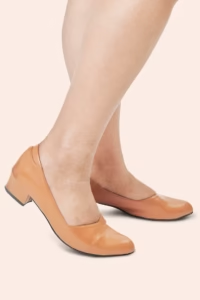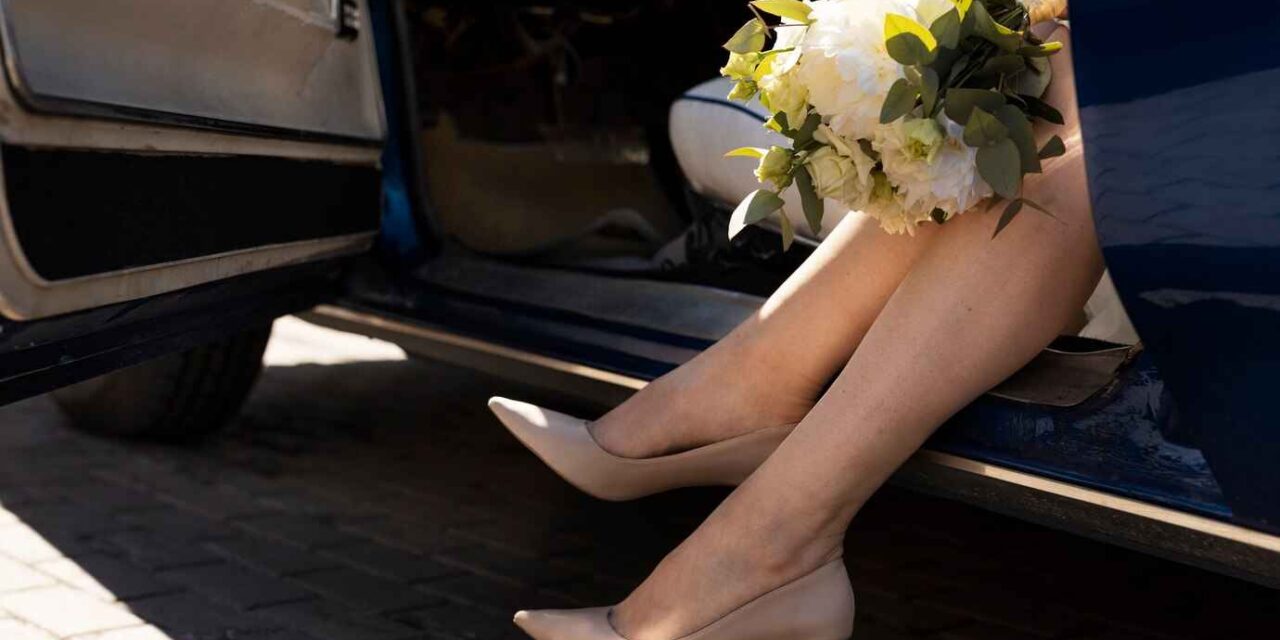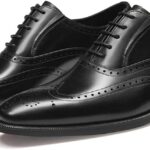Selecting the correct shoes interests more than simply choosing a style or size; it also involves knowing how different foot sizes and shapes move comfort and general foot health. Standard-sized shoes repeatedly do not give wide-footed women the space they need, which can result in long-term issues like foot bumps, foot pain, or bad attitude.
Everything you need to know about wide women’s shoes will be covered in this book, including why they are necessary, how to tell if you need them, and which kind of shoes are comfortable for broad feet.
Why Some Women Need Wide Shoes
Everybody has unique feet. Some people’s feet are naturally narrow, whereas others are naturally larger, especially in the forefoot or toe area. Genetics, ageing, weight changes, pregnancy, or certain illnesses can all be to blame for this.
Trying to embrace wide feet into standard-width shoes can cause:
- Pain and cramping
- Blisters and corns
- Inflammation and swelling
- Alignment issues in the knees or hips
Wearing broad women’s shoes is, therefore, necessary for preventing everyday discomfort as well as for supporting healthy foot position, lowering the likelihood of ongoing pain, and preserving joint health and long-term motion as you age.
Understanding Shoe Widths
Letters are often employed to indicate shoe widths, which might initially be confusing. Finding a pair that truly matches the shape of your foot, however, is far simpler once you know what each letter represents. The meaning of these width letters in women’s shoes is broken down simply as follows:
- B or M (Medium): The standard width for women.
- D or W (Wide): Slightly more space in the forefoot and toe area.
- 2E or WW (Extra Wide): Provides significantly more width for wider feet or swelling.
- 4E: Extremely wide, used for specific foot conditions or post-surgery comfort.
Selecting the right width is equally important as selecting the right length. Even with the right length, a shoe that is too thin can hurt.
Wide vs. Extra Wide: What is the Difference?
The greater room across the ball of the foot and toe box separates wide women’s shoes from extra wide women’s footwear. Women with physical illnesses, chronic swelling, or foot defects are frequently advised to wear extra-wide shoes.
Changing to extra wide shoes could assist if wide shoes still feel tight or put pressure on the toes or sides of your feet.
Signs You Might Need Wide Shoes
Do you have concerns about your shoes being too narrow? When anything is wrong, your feet often give you clear signs. The following are common signs that your present shoes may be too tight:
- It feels like someone is pushing or squeezing your pinky toe.
- After wearing shoes, you notice burns or red marks on the sides of your feet.
- You experience foot fatigue quickly when walking.
- You have developed bunions or corn from pressure.
These are all indicators that your feet need more room—and women’s shoes’ wide sizes could provide the relief you are looking for.
The Best Shoe Shapes for Wide Feet
Certain shoe shapes are simply a better match for wide feet because they offer more room where it is needed most. In general, the most comfortable choices tend to be shoes that have:
- A round or square–toe box
- A deep and flexible upper
- A better fit will be obtained with adjustable fixings like elastic or laces.
On the other hand, a lack of natural toe action in narrow-heeled or pointed-toe shoes can result in not enough circulation, pressure advertising, and, finally, painful foot issues, including bumps, toe misalignment, or joint issues.
What Type of Footwear Suits Wide Feet?
For large feet, the building of a shoe and what is used can have a significant impact. Proper footwear provides both support and room. Shoes that work well for wide feet often include features like:
- Sneakers with mesh uppers for flexibility and breathability
- Sandals with adjustable straps to allow a custom fit
- Boots with a wider base and roomy toe area
- Orthopaedic-style shoes designed for foot health
- Shoes with a supportive sole and low heels
The secret is to wear shoes that allow your feet to move naturally, allowing your toes to stretch, your arches to be properly supported, and your steps to be free without putting excessive pressure on your foot or making it walk abnormally.
How to Measure Your Feet for Width
Here is a quick and easy way to measure your actual shoe width at home if you wish to:
- Draw both feet while standing on a sheet of paper.
- Measure the widest part of each foot.
- Compare the measurement to a standard shoe width chart.
- Since most people have one foot that is larger than the other, always count both feet.
Your feet grow to swell a little after a long day of standing and walking, so it is best to count them in the evening. This will give you a more natural and exact size that matches their actual size throughout everyday movements.
What Shape of Shoe is Best for Wide Feet?
Wasting time-fighting against your foot’s natural shape, the best shoes conform to it. If your feet are wide, you should often look for shoes with the following features:
- Wide toe box to allow your toes to spread naturally
- Rounded front instead of pointed
- Supportive heel without being narrow or high
- Low or no arch pressure
Each move feels easier and more balanced when you wear shoes that fit your foot’s natural shape. They also help move pressure evenly, lessen muscle tension, and boost softer, more effective activity.
What Shoes to Avoid If You Have Wide Feet
While there are plenty of excellent shoe options for people with broad feet, some designs might prove more harmful than beneficial. Avoid these kinds of shoes if you value comfort and the health of your feet:

- Shoes with pointed toes: It can cause problems with balance by pressing the toes.
- Narrow-base high heels: Put more strain on the foot’s ball.
- Ballet shoes: These have thin, flat soles and do not support the heel or hip.
- Lack of elastic in slip-on shoes: They may feel overly tight across the top of the foot.
You can lessen discomfort if you at times have to wear these narrow or less supporting shoe styles by adding special inserts that give your feet more room and comfort or by using shoe stretchers to widen the fit over time.
Do Wide Shoes Help With Foot Pain?
Yes—many people find that wearing broad shoes helps greatly reduce or prevent the foot pain they have been experiencing. This is especially true for pain brought on by illnesses such as:
- Bunions
- Plantar fasciitis
- Hammertoes
- Corns and calluses
- General inflammation
Your body’s weight falls uniformly across the whole cover of your foot when you wear shoes that fit correctly. This helps your total body move more comfortably and naturally by bypassing pressure spots and soreness and enabling better positioning in your ankles, knees, and hips.
Women’s Wide-Width Shoes for Problem Feet
Lifestyle choices, genetics, or medical diseases in certain women can bring on chronic pain and foot issues. Wide women’s footwear for troublesome feet can assist in controlling discomfort and stop more problems in these situations.
These shoes often come with:
- Removable insoles for custom orthotics
- Shock-absorbing soles
- Seam-free linings for sensitive skin
- Extra depth for toe movement
These shoes can be beneficial for people with diabetes due to their secure and pressure-relieving real estate, but their supportive design and extra soft and deep materials make them an excellent choice for everyday wear, mostly for people who want to improve their comfort and foot care.
Can I Wear Wide Shoes If I Have Normal Feet?
It varies. Wearing broad shoes may still be comfortable even if your feet are not very large, but you want a looser fit when they become swollen. On the other hand, wearing too wide shoes all the time may cause instability or burns from friction.
What is the Best Shoe Width for Wide Feet?
Most women with larger feet generally find a better fit by starting with these popular shoe width selections, while there is not a single ideal width that suits everyone:
- D (Wide) is a good starting point.
- 2E (Extra Wide) is ideal for very wide or swollen feet.
- 4E is typically used for severe width needs or medical conditions.
You may find the most ideal and confirmed fit for your unique foot form and needs by testing with different shoe widths or conferring with a doctor who is knowledgeable in foot design and health.
What Shoes Do Foot Doctors Recommend?
Foot health specialists often advise exploring specific important parts in shoes—those that support your feet and help avoid pain and long-term issues. Usually, the following qualities consist of:
- Adequate width and depth to avoid squeezing
- Arch support to promote healthy alignment
- Shock-absorbing soles to reduce pressure on joints.
- Breathable materials to prevent sweating and odour
You no longer have to pick between comfort and style when looking for shoes that actually fit because an increasing number of medical and sports shoe brands are accepting both fashion and beauty functions. These businesses provide fashionable designs in wide and extra-wide sizes.
Wide Women’s Shoes Solution
Broad Shoes for Women The solution is smarter comfort, not just larger sizes. Your shoes, not your stride, may be the real issue if your feet are always weak, achy, or tight. Your feet may breathe, move freely, and remain invested all day long in the proper wide-fitting shoes. A well-fitting, wide-width pair of shoes can be a huge help if you are racing kids, walking to work, or just want to feel comfortable. It is foot freedom, not simply shoes.
Give Your Toes a Break—They are Not Sardines!”
It is time for a change if your shoes feel more like foot nets than shoes. Wide feet are simply not made to fit into tight shoes; it is like trying to fit a sleeping bag into a pocketbook! Women’s wide shoes are the comfortable, expansive option your feet have been longing for. They allow your toes to flex, stretch, and, at last, stop moaning. Bid farewell to blisters, red markings, and a limp as if you have just finished a small race. Not only are wide shoes useful, but they also work as a kind of agreement between your feet and you.
FAQs About Above Information
How do I know if I need wide women’s shoes?
If you experience sores on the sides of your feet, your toes feel squeezed, or your shoes always feel tight, even when they are the proper length, you may need wide shoes. Red markings, bunions, or foot fatigue after walking are typical symptoms. It is worthwhile to measure the breadth of your foot and try on wide-width shoes if any of these sound similar.
What is the difference between wide and extra-wide shoes?
Wide shoes (often labelled “D” or “W”) give more room than regular sizes. Extra wide (like “2E” or “WW”) offers even more space in the toe box and across the foot. If wide shoes still feel tight or press on your feet, extra wide might be the better fit.
Are certain shoe shapes better for wide feet?
Indeed. The ideal shoes for large feet have a deep upper and a round or square toe box. These lessen pressure and let your toes extend out naturally. Shoes with a tight top or pointed toes should be avoided since they might press the foot and create discomfort.
Can wearing wide shoes help with foot pain?
Of course. The combination and pressure relief are two benefits of wearing shoes that fit your foot width. They can aid in the relief of heel pain, bunions, and other foot problems. Less friction, less irritation, and improved foot health are all results of a proper fit.
What should I look for in wide shoes for everyday use?
Look for these features:
- A roomy toe box
- Supportive soles
- Adjustable straps or laces
- Breathable materials
- Cushioned insoles or removable orthotics
By allowing your feet the room they require to move freely, removing pressure on areas of concern, and avoiding regular issues like rubbing, touching, or aching—even after hours of wear—shoes with these well-considered parts offer all-day support.
Conclusion
Sporting the correct shoes is about more than just looking good; it is about making sure your feet stay pain-free over time, your steps are easy, and your body feels invested. Seeing shoes that fit correctly in terms of both height and length is not an extra for someone with large feet; instead, it is a need. You can stay active, control pain, and take daily care of your general health when you have a good fit.
The good news? Brands have learned that feet vary widely in size and form. As a result, wide-width shoes are now more readily available and better made than before. How you walk, how your feet feel, and even how confidently you go about your day will all change greatly when you know how to pick shoes that fit your foot shape.
Read More:
Average Woman Shoe Size in 2025: The Superior Fit & Trends Overview










